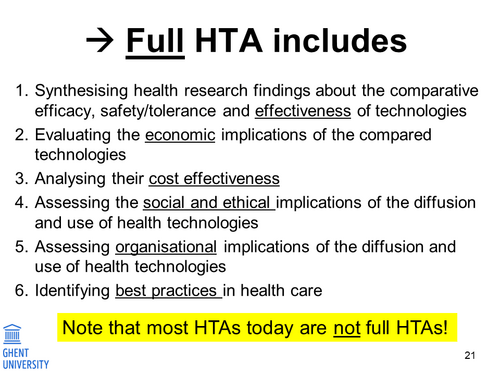In the ever-evolving landscape of healthcare, it is crucial for all stakeholders to stay informed about the latest trends and opportunities. One such critical area is Health Technology Assessment (HTA), which plays a significant role in shaping healthcare policies and decision-making across Europe. In this short article, Prof. Dr. Lieven Annemans, CELforPharma faculty member of the course Critical New HTA Developments in Europe: Challenges & Solutions gives a quick overview of the components that can be part of an HTA.
What is a Full Health Technology Assessment?
A full HTA comprises six components, each requiring in-depth analysis and understanding. It is worth noting that many HTAs conducted today are not full HTAs.
The six components of a full HTA are:
Synthesising health research findings about the comparative efficacy, safety/tolerance, and effectiveness of technologies. This involves a comprehensive review of published studies and clinical trials to determine how the new technology compares to existing treatments. The key question is: how much better is it for patients (more quality of life and/or life expectancy) and for the healthcare system (e.g. avoided hospitalisations).
The economic implications. What are the direct (healthcare use and costs) and indirect (productivity related) costs associated with the new treatments compared to the costs of existing treatments. To which extent can the extra cost of the new treatment be offset by savings elsewhere? Hence, what is the net cost of the new technology?
The cost-effectiveness analysis of the new technology. Putting 1. and 2. together, this component involves determining whether the new technology provides enough health benefits to justify the net cost compared to existing treatments.
The social and ethical implications of the diffusion and use of health technologies. Considerations are made on how the new technology will affect patients, their families, and society as a whole.
The organisational implications of the diffusion and use of health technologies. This step involves considering the impact of the new technology on healthcare providers and organisations, including its integration into existing systems and workflows.
Identifying best practices in healthcare and assessing how the new technology can be optimally used to improve the overall quality of care for patients and health systems performance. So, it’s not the technology as such that is assessed, but the way it is applied.

Navigating the Challenges of HTAs in Europe
Successfully planning for HTAs in Europe is a highly complex undertaking, considering the intricate analysis required for each component and the varying approaches adopted by different countries. To navigate these complexities, everyone involved in the process must develop a thorough understanding of the needs and processes of the various healthcare bodies across the region.
